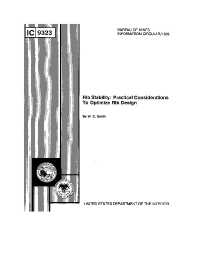Mining Publication: Rib Stability: Practical Considerations to Optimize Rib Design
Original creation date: January 1992
The Bureau of Mines examined previous research on rib stability in an effort to develop a practical approach to understanding, characterizing, and controlling weak rib conditions in underground coal mines. Because success in stabilizing ribs depends on a basic knowledge of how weak ribs behave, the report reviews the mechanics of rib failure and the relationship of coal mine geology and pillar constraint to rib instability. Strategies for choosing an effective method of rib support are considered, and various rib support methods are discussed. Finally, the report documents techniques for monitoring ribs and use of models to assess rib stability; such monitoring and modeling can also help determine the most effective method for roof support.
Authors: WC Smith
Information Circular - January 1992
NIOSHTIC2 Number: 10011370
U.S. Department of the Interior, Bureau of Mines, Information Circular 9323, 1992 Jan:1-16
See Also
- A CART Technique to Adjust Production from Longwall Coal Operations under Ventilation Constraints
- CFD Modeling of Fire Spread Along Combustibles in a Mine Entry
- Current Trends in Reducing Ground Fall Accidents in US Coal Mines
- Managing Excess Gas Emissions Associated with Coal Mine Geologic Features
- MCP - Methane Control and Prediction - 2.0
- Modeling and Data Analysis of 50 to 5000 kHz Radio Wave Propagation in Coal Mines
- Pillar Mechanics of Coal Mine Bursts: A Control Strategy
- Reservoir Modeling-Based Prediction and Optimization of Ventilation Requirements During Development Mining in Underground Coal Mines
- Variation of Horizontal Stresses and Strains in Mines in Bedded Deposits in the Eastern and Midwestern United States
- Water and Slurry Bulkheads in Underground Coal Mines: Design, Monitoring, and Safety Concerns
- Content source: National Institute for Occupational Safety and Health, Mining Program


 ShareCompartir
ShareCompartir
